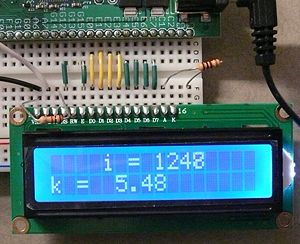Difference between revisions of "NU32: 16x2 LCD"
NickMarchuk (talk | contribs) |
|||
| Line 32: | Line 32: | ||
</table> |
</table> |
||
The VEE pin on the LCD sets the contrast of the characters on the LCD. Create with a voltage around 1V using a 10k pot to get a nice contrast, or hook it to GND through a 1.5kOhm resistor, which also seems to work well. |
The VEE pin on the LCD (labeled 'A') sets the contrast of the characters on the LCD. Create with a voltage around 1V using a 10k pot to get a nice contrast, or hook it to GND through a 1.5kOhm resistor, which also seems to work well. |
||
If you power the LCD but do not send it any commands, the top row should fill with boxes. Use this to set your contrast and check that your LCD works. |
If you power the LCD but do not send it any commands, the top row should fill with boxes. Use this to set your contrast and check that your LCD works. |
||
Revision as of 12:33, 8 February 2012
Parallel LCD
The popular HD44780 (and compatible chipsets) can be interfaced to the NU32 PIC32 board using 11 pins for easy character output to an LCD. This can be highly useful in either debugging or generating a more complex user interface for a PIC (or other microcontroller)-based device.
This implementation of an HD44780 LCD uses 11 I/O on the PIC as output only, so it is not optimized for speed.
LCD Hookup
The LCD uses the following connections with the NU32:
| LCD Pin | PIC Pin |
| 1 - VSS | GND |
| 2 - VDD | +5V |
| 3 - V0 | ~1.5k resistor to GND |
| 4 - RS | G12 |
| 5 - RW | G13 |
| 6 - E | G15 |
| 7 - D0 | E0 |
| 8 - D1 | E1 |
| 9 - D2 | E2 |
| 10 - D3 | E3 |
| 11 - D4 | E4 |
| 12 - D5 | E5 |
| 13 - D6 | E6 |
| 14 - D7 | E7 |
| 15 - A | 100 ohm resistor to 3.3V |
| 16 - K | GND |
The VEE pin on the LCD (labeled 'A') sets the contrast of the characters on the LCD. Create with a voltage around 1V using a 10k pot to get a nice contrast, or hook it to GND through a 1.5kOhm resistor, which also seems to work well.
If you power the LCD but do not send it any commands, the top row should fill with boxes. Use this to set your contrast and check that your LCD works.
The NU32 board is based on 3.3V logical outputs, which works fine for most LCDs, but this LCD must be supplied with 5V on VDD.
LCD Commands
In the main.c file, before the main while loop, you must initialize the LCD
setupLCD();
The basic command used to write to the LCD is
LCDWriteString("Hello World", 1, 2);
where 1 is the first row (options are 1 or 2), and 2 is the location to start in (options 1-16). There are only 16 characters per row, so don't try to print a string with more than 16 characters!
You can clear everything on the LCD by using
LCDClear(0);
Write the contents of a variable using
sprintf(LCD_Out_Buffer,"k = %5.2f", k);
LCDWriteString(LCD_Out_Buffer, 2, 1);
LCD_Out_Buffer is a 16 element char array declared in LCD.h Use sprintf just like in serial communication, but pay attention to the modifies to your variable. In this case, k is a float, and we don't want to print every character in the decimal number. %5.2f means use at least 5 characters (including the .) to represent the number, but only two decimals, so we should see 12.34, not 12.345, but we could see 123.45, and _1.23, where _ is really a blank space.
Files and Example Code
Include the following h and c files to your project: h and c files
